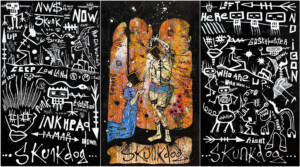artist/ SKUNKDOG
FRANCE

-
DAVID PLUSKWA
F16-G13
It all started with books, music, a feeling of social unsatisfaction, punk movement, Bob Dylan and Patti Smith -who gave him his nickname, Skunkdog. It also started with the street, its constant hustle and bustle, advertisements and graffiti. The artists draws his energy from there, as well as the framework of his creative research. After many trials and errors, painting finally became the medium of his yearn for self-expression, maybe because the language of colors is more generous that words, giving both the creator and viewer, an immediate sensorial experience words cannot provide. And also because it is the type of work one can do without alienating oneself, even better, that demands to surpass oneself.
For Skunkdog, this total freedom of the painter in front of the canvas was a revelation; so much that he threw himself body and soul into it, with a fierce passion for seeing his pencils and paintbrushes giving shape to new forms and signs. Nature abhors a vacuum. And so does Skunkdog, who fills up every inch of his canvases. His natural sense for technical experiment led him to turn each work into a research on material. Mixing clay, coffee and resin while scratching and ripping the surface of his paintings like a wall tagged and erased over and over, Skunkdog’s canvases are the space of his imaginary projections. Fantasies, memories, cultural references, even poetic quotes: his works absorb, transform and reflect everything the artist’s fertile mind puts into it.
Rare are the artists who feed their brain with such a large panel of the information sources modern society provides. However, thanks to his extraordinary memory, Skunkdog has progressively returned to the most ancestral artistic gestures, revisiting the great myths that shape our collective sensitivity and appropriating them in his flat-tint paintings. There is no absolute beginning in our world.
Even though Skunkdog has found his style in the street, his topics and protagonists are not realistic. They don’t come -or very rarely- from his observation of the world, but from emotions inspired by other artworks, artists and times. Proof being the many paintings of this exhibition that represent emblematic religious figures like Adam and Eve, the Christ on the cross or Saint Sebastian. Their postures directly point to some of the Nordic masters like Durer, Grunewald and Cranach. But one should not look for a mystical exaltation behind the narrative variations proposed by the painter: the pink lips of his crucified Jesus rather underlines an ironic distancing and the exclusively esthetic dimension of his approach. However, his paintings follow in the footsteps of a tradition and prolong the history of Western painting.
Women are certainly another major theme of his painting. But not just any woman: the very eroticized figure of the prostitute, with eyes heavily made up, snake-like hairs, fallen angel wings and Arlequin costumes. One cannot but think of Auguste Chaubaud, a major representative of Provence expressionism and a lover of whorehouses (who Skunkdog greatly admires); or of Egon Schiele, who often used prostitutes as models as well. Besides, this topic provides a pretext for many interesting graphic (sharp features, fishnet) and chromatic effects (contrasts between primary colors like red and green). For painting has its reasons that the artist cannot ignore.
Robots are also a theme which recurrent, if not invasive presence in many of Skunkdog’s paintings, could hardly be ignored. Are they telling us about our world’s -frightening- future in a 21st century doomed to so many promethean perspectives? Or is it merely a reminder of the artist’s taste for SF literature and authors like Isaac Asimov?
Between abstraction and figuration, Skunkdog is forging his own heraldic language, each painting being like a coat of arms, a sort of biographic encrypted message for the audience and collectors. As for his signature, it has become unmistakable. If art is a matter of name, it looks like Skunkdog has chosen his well.














